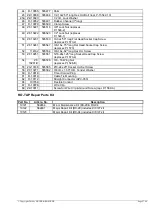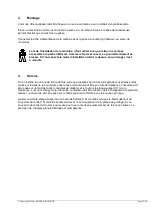
© Copyright 2010 by HAVER & BOECKER
Page 22/44
7.
Performing the sieve analysis
In order to receive precise sieving results, the kind of procedure should be determined before starting the
sieve analysis. The bulk volume, the feeding quantity, the sieving time and the desired sieving precision
should be pre-determined. The RO-TAP has been constructed for dry sieving. For wet sieving with the
RO-TAP a special wet-sieving-kit is available.
8.
Determination of bulk volume
The optimum bulk volume can be determined by regarding several factors: the weight of bulk material
and its material properties such as sieving capacity, particle size and distribution. For example a sieve
analysis of a solid material with a coarse particle distribution needs a feeding with bulk material of about
25 to 100 grams.
Often too large feeding quantities are filled in. To receive uniform results it is better to fill in smaller, well
taken sample quantities. During a reliable sieve analysis each solid particle must have the possibility to
be retained or to pass the sieve openings to the smaller ones of the following sieve. In a test sieve set of
six or seven sieves a small particle must repeat this operation six or seven times. If the test sieves are
overloaded a small particle may not have the chance to drop down to the right sieve bottom. However the
feeding quantity has to be large enough to enable the first test sieve to retain enough particles, that are
representative for the good to be analyzed.
The weight of the sieving material should be limited to a size that no sieve in the sieve set shall be
overloaded. Overloading of test sieves may arise when sieving analyses are effectuated with a high
degree on cut-point-close particles in the sieving material. To avoid overloading the capacities of the test
sieves should be taken into account, especially the capacity of the sieve that has to retain the largest
residue. Any overloading leads to uncertain results, because a lot of meshes may be blocked by particles.
The following procedure is recommended to determine the feeding quantity for test sieves: Divide the
material to be analyzed with a sample splitter into samples with different weights: approx. 25, 50, 100,
150 and 200 grams. Analyze these samples on the test sieve set for about 5 minutes. When comparing
the results it should be obvious, which feeding quantity leads to an optimum result. If the results, defined
in percent of the residue, of a 100 gram sample are the same as the 50 gram and 150 gram sample and
show a smaller mass fraction on the finest test sieve, 100 gram is the right feeding quantity to perform a
sieving analysis.
Cut-point-close particles are particles, that show a particle size approaching the cut point of a test sieve.
To achieve correct analyzes this test sieve should be fed slightly to enable each of the cut-point-close
particles to meet the openings as often as possible.
Содержание TYLER Ro-Tap RX-29
Страница 14: ...Copyright 2010 by HAVER BOECKER Page 14 44 Bild 1 1...
Страница 15: ...Copyright 2010 by HAVER BOECKER Page 15 44 Bild 2 1...
Страница 28: ...Copyright 2010 by HAVER BOECKER Page 28 44 picture 1 1...
Страница 29: ...Copyright 2010 by HAVER BOECKER Page 29 44 picture 2 1...
Страница 43: ...Copyright 2010 by HAVER BOECKER Page 43 44 Fig 1 1...
Страница 44: ...Copyright 2010 by HAVER BOECKER Page 44 44 Fig 2 1...
















































